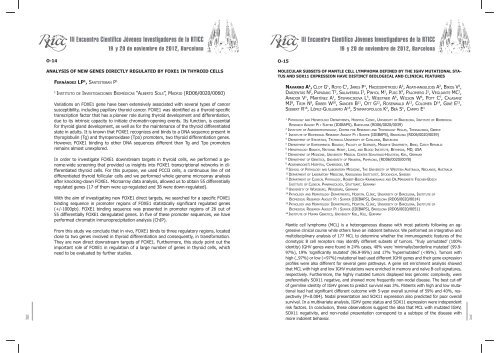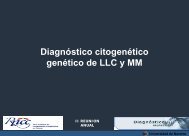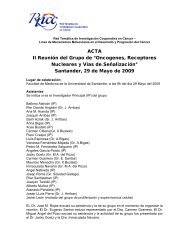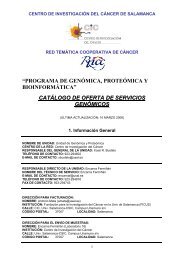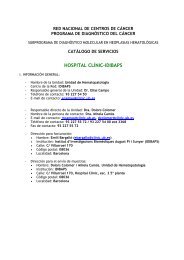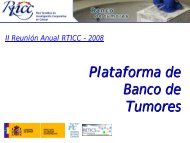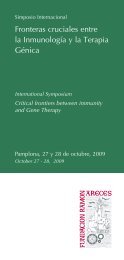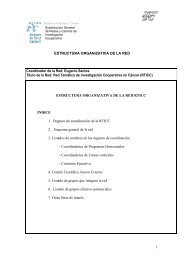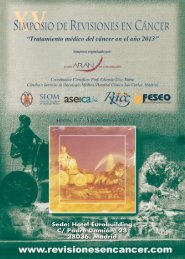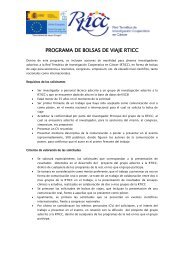Untitled - Red Temática de investigación cooperativa en cáncer
Untitled - Red Temática de investigación cooperativa en cáncer
Untitled - Red Temática de investigación cooperativa en cáncer
You also want an ePaper? Increase the reach of your titles
YUMPU automatically turns print PDFs into web optimized ePapers that Google loves.
O-14<br />
ANALYSIS OF NEW GENES DIRECTLY REGULATED BY FOXE1 IN THYROID CELLS<br />
FERNÁNDEZ LP 1 , SANTISTEBAN P 1<br />
1<br />
INSTITUTO DE INVESTIGACIONES BIOMÉDICAS “ALBERTO SOLS”, MADRID (RD06/0020/0060)<br />
Variations on FOXE1 g<strong>en</strong>e have be<strong>en</strong> ext<strong>en</strong>sively associated with several types of cancer<br />
susceptibility, including papillary thyroid cancer. FOXE1 was i<strong>de</strong>ntified as a thyroid-specific<br />
transcription factor that has a pioneer role during thyroid <strong>de</strong>velopm<strong>en</strong>t and differ<strong>en</strong>tiation,<br />
due to its intrinsic capacity to initiate chromatin-op<strong>en</strong>ing ev<strong>en</strong>ts. Its function, is ess<strong>en</strong>tial<br />
for thyroid gland <strong>de</strong>velopm<strong>en</strong>t, as well as for the maint<strong>en</strong>ance of the thyroid differ<strong>en</strong>tiated<br />
state in adults. It is known that FOXE1 recognizes and binds to a DNA sequ<strong>en</strong>ce pres<strong>en</strong>t in<br />
thyroglobulin (Tg) and thyroperoxidase (Tpo) promoters, two thyroid differ<strong>en</strong>tiation g<strong>en</strong>es.<br />
However, FOXE1 binding to other DNA sequ<strong>en</strong>ces differ<strong>en</strong>t than Tg and Tpo promoters<br />
remains almost unexplored.<br />
In or<strong>de</strong>r to investigate FOXE1 downstream targets in thyroid cells, we performed a g<strong>en</strong>ome-wi<strong>de</strong><br />
scre<strong>en</strong>ing that provi<strong>de</strong>d us insights into FOXE1 transcriptional networks in differ<strong>en</strong>tiated<br />
thyroid cells. For this purpose, we used PCCl3 cells, a continuous line of rat<br />
differ<strong>en</strong>tiated thyroid follicular cells and we performed whole g<strong>en</strong>ome microarray analysis<br />
after knocking-down FOXE1. Microarray data analysis, allowed us to obtain 55 differ<strong>en</strong>tially<br />
regulated g<strong>en</strong>es (17 of them were up-regulated and 38 were down-regulated).<br />
O-15<br />
MOLECULAR SUBSETS OF MANTLE CELL LYMPHOMA DEFINED BY THE IGHV MUTATIONAL STA-<br />
TUS AND SOX11 EXPRESSION HAVE DISTINCT BIOLOGICAL AND CLINICAL FEATURES<br />
NAVARRO A 1 , CLOT G 1 , ROYO C 1 , JARES P 1 , HADZIDIMITRIOU A 2 , AGATHANGELIDIS A 2 , BIKOS V 2 ,<br />
DARZENTAS N 2 , PAPADAKI T 2 , SALAVERRIA I 3 , PINYOL M 1 , PUIG X 4 , PALOMERO J 1 , VEGLIANTE MC 1 ,<br />
AMADOR V 1 , MARTÍNEZ A 1 , STEFANCIKOVA L 5 , WIESTNER A 6 , WILSON W 6 , POTT C 7 , CALASANZ<br />
MJ 8 , TRIM N 9 , ERBER W 10 , SANDER B 11 , OTT G 12 , ROSENWALD A 13 , COLOMER D 14 , GINÉ E 15 ,<br />
SIEBERT R 16 , LÓPEZ-GUILLERMO A 15 , STAMATOPOULOS K 2 , BEÀ S 1 , CAMPO E 1<br />
1<br />
PATHOLOGY AND HEMATOLOGY DEPARTMENTS, HOSPITAL CLÍNIC, UNIVERSITY OF BARCELONA, INSTITUTE OF BIOMEDICAL<br />
RESEARCH AUGUST PI I SUNYER (IDIBAPS), BARCELONA (RD06/0020/0039)<br />
2<br />
INSTITUTE OF AGROBIOTECHNOLOGY, CENTER FOR RESEARCH AND TECHNOLOGY HELLAS, THESSALONIKI, GREECE<br />
3<br />
INSTITUTE OF BIOMEDICAL RESEARCH AUGUST PI I SUNYER (IDIBAPS), BARCELONA (RD06/0020/0039)<br />
4<br />
DEPARTMENT OF STATISTICS, TECHNICAL UNIVERSITY OF CATALONIA, BARCELONA<br />
5<br />
DEPARTMENT OF EXPERIMENTAL BIOLOGY, FACULTY OF SCIENCES, MASARYK UNIVERSITY, BRNO, CZECH REPUBLIC<br />
6<br />
HEMATHOLOGY BRANCH, NATIONAL HEART, LUNG, AND BLOOD INSTITUTE, BETHESDA, MD, USA<br />
7<br />
DEPARTMENT OF MEDICINE, UNIVERSITY MEDICAL CENTER SCHLESWIG-HOLSTEIN, KIEL, GERMANY<br />
8<br />
DEPARTMENT OF GENETICS, UNIVERSITY OF NAVARRA, PAMPLONA, (RD06/0020/0078)<br />
9<br />
ADDENBROOKE’S HOSPITAL, CAMBRIDGE, UK<br />
10<br />
SCHOOL OF PATHOLOGY AND LABORATORY MEDICINE, THE UNIVERSITY OF WESTERN AUSTRALIA, NEDLANDS, AUSTRALIA<br />
11<br />
DEPARTMENT OF LABORATORY MEDICINE, KAROLINSKA INSTITUTET, STOCKHOLM, SWEDEN<br />
12<br />
DEPARTMENT OF CLINICAL PATHOLOGY, ROBERT-BOSCH-KRANKENHAUS AND DR.MARGARETE FISCHER-BOSCH<br />
INSTITUTE OF CLINICAL PHARMACOLOGY, STUTTGART, GERMANY<br />
13<br />
UNIVERSITY OF WÜRZBURG, WÜRZBURG, GERMANY<br />
With the aim of investigating new FOXE1 direct targets, we searched for a specific FOXE1<br />
binding sequ<strong>en</strong>ce in promoter regions of FOXE1 statistically significant regulated g<strong>en</strong>es<br />
(+/-1000pb). FOXE1 binding sequ<strong>en</strong>ce was pres<strong>en</strong>ted in promoter regions of 26 out of<br />
55 differ<strong>en</strong>tially FOXE1 <strong>de</strong>regulated g<strong>en</strong>es. In five of these promoter sequ<strong>en</strong>ces, we have<br />
performed chromatin inmunoprecipitation analysis (ChIP).<br />
From this study we conclu<strong>de</strong> that in vivo, FOXE1 binds to three regulatory regions, located<br />
close to two g<strong>en</strong>es involved in thyroid differ<strong>en</strong>tiation and consequ<strong>en</strong>tly, in transformation.<br />
They are new direct downstream targets of FOXE1. Furthermore, this study point out the<br />
important role of FOXE1 in regulation of a large number of g<strong>en</strong>es in thyroid cells, which<br />
need to be evaluated by further studies.<br />
14<br />
PATHOLOGY AND HEMATOLOGY DEPARTMENTS, HOSPITAL CLÍNIC, UNIVERSITY OF BARCELONA, INSTITUTE OF<br />
BIOMEDICAL RESEARCH AUGUST PI I SUNYER (IDIBAPS), BARCELONA (RD06/0020/0014)<br />
15<br />
PATHOLOGY AND HEMATOLOGY DEPARTMENTS, HOSPITAL CLÍNIC, UNIVERSITY OF BARCELONA, INSTITUTE OF<br />
BIOMEDICAL RESEARCH AUGUST PI I SUNYER (IDIBAPS), BARCELONA (RD06/0020/0051)<br />
16<br />
INSTITUTE OF HUMAN GENETICS, UNIVERSITY KIEL, KIEL, GERMANY<br />
Mantle cell lymphoma (MCL) is a heterog<strong>en</strong>eous disease with most pati<strong>en</strong>ts following an aggressive<br />
clinical course while others have an indol<strong>en</strong>t behavior. We performed an integrative and<br />
multidisciplinary analysis of 177 MCL to <strong>de</strong>termine whether the immunog<strong>en</strong>etic features of the<br />
clonotypic B cell receptors may i<strong>de</strong>ntify differ<strong>en</strong>t subsets of tumors. ‘Truly unmutated’ (100%<br />
i<strong>de</strong>ntity) IGHV g<strong>en</strong>es were found in 24% cases, 40% were ‘minimally/bor<strong>de</strong>rline mutated’ (99.9-<br />
97%), 19% ‘significantly mutated’ (96.9-95%) and 17% ‘hypermutated’ (


